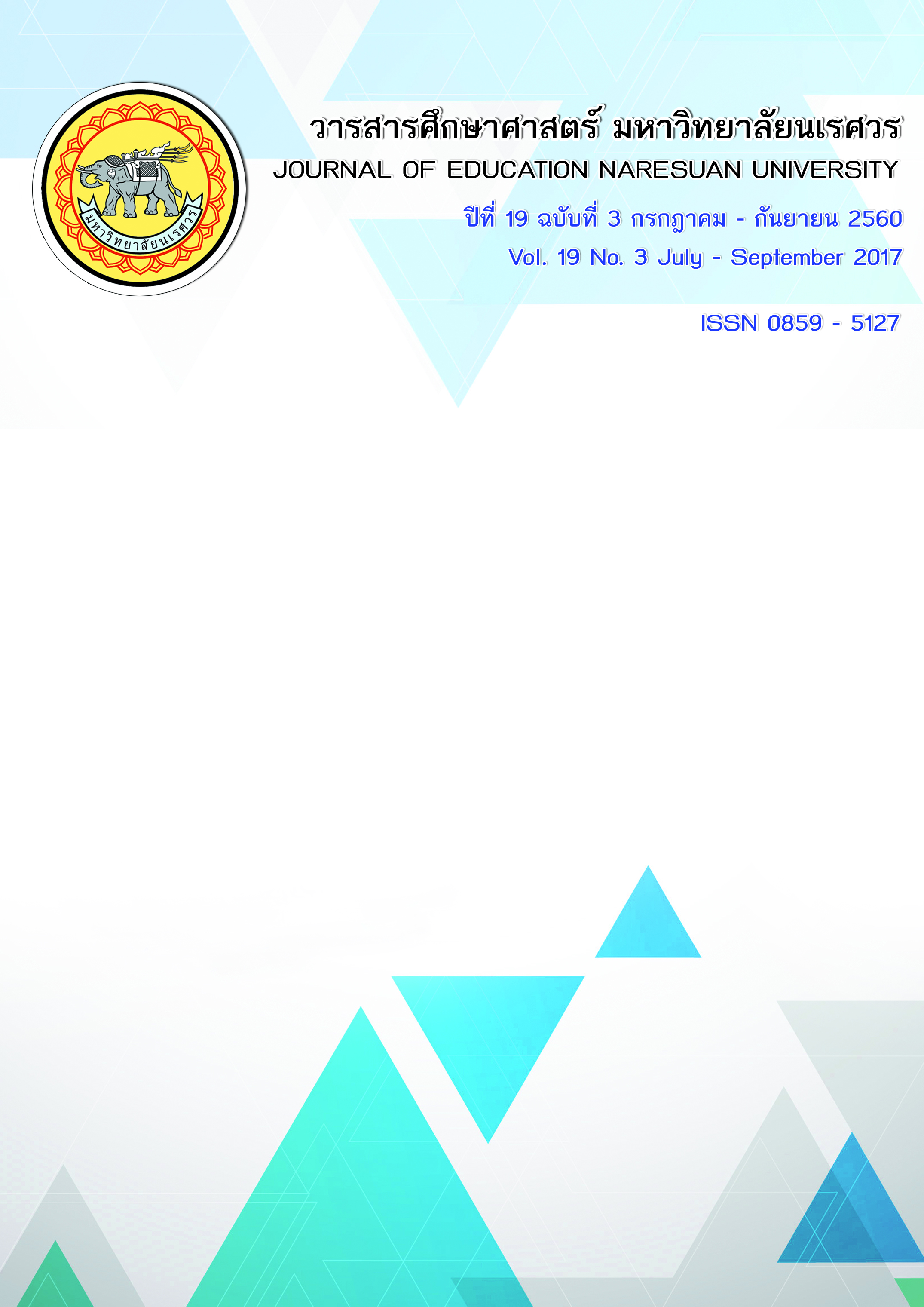การพัฒนาบทเรียนตามแนวการสอนภาษาที่เน้นเนื้อหาเพื่อส่งเสริมความสามารถในการพูดภาษาอังกฤษและความรู้ท้องถิ่นของนักเรียนชั้นมัธยมศึกษาปีที่ 6
Main Article Content
Abstract
การวิจัยครั้งนี้มีวัตถุประสงค์เพื่อ 1) พัฒนาบทเรียนภาษาอังกฤษตามแนวการสอนภาษาที่เน้นเนื้อหา 2) เปรียบเทียบความสามารถในการพูดนำเสนอเป็นภาษาอังกฤษกับเกณฑ์ร้อยละ 60 3) เปรียบเทียบความรู้ท้องถิ่นของผู้เรียนก่อนและหลังการเรียนบทเรียนภาษาอังกฤษตามแนวการสอนภาษาที่เน้นเนื้อหา กลุ่มเป้าหมายที่ใช้ในการวิจัยครั้งนี้ เป็นผู้เรียนชั้นมัธยมศึกษาปีที่ 6/1 โรงเรียนเวียงแหงวิทยาคม อำเภอเวียงแหง จังหวัดเชียงใหม่ ที่เรียนวิชาภาษาอังกฤษฟัง พูด 3 (อ30205) ในภาคเรียนที่ 1 ปีการศึกษา 2558 จำนวน 34 คน เครื่องมือที่ใช้ในการวิจัยครั้งนี้มี 3 ประเภท คือ ประเภทที่ 1 เครื่องมือสำหรับการสร้างบทเรียน ได้แก่ แบบสำรวจความต้องการและความสนใจ หลักสูตรแม่แบบและบทเรียนภาษาอังกฤษตามแนวการสอนภาษาที่เน้นเนื้อหาจำนวน 5 แผนการจัดการเรียนรู้ ประเภทที่ 2 เครื่องมือประเมินผลการพัฒนาบทเรียน ได้แก่ แบบประเมินประสิทธิภาพบทเรียนภาษาอังกฤษตามแนวการสอนภาษาที่เน้นเนื้อหา ประเภทที่ 3 เครื่องมือที่ใช้ในการเก็บรวบรวมข้อมูล ได้แก่ แบบประเมินความสามารถในการพูดนำเสนอเป็นภาษาอังกฤษและแบบทดสอบวัดความรู้เนื้อหาท้องถิ่น ผู้วิจัยนำข้อมูลที่ได้มาวิเคราะห์หาค่าเฉลี่ย ส่วนเบี่ยงเบนมาตรฐาน และค่าร้อยละ ผลการวิจัยสรุปได้ ดังนี้
1. บทเรียนภาษาอังกฤษตามแนวการสอนภาษาที่เน้นเนื้อหา ประกอบไปด้วยหลักสูตรแม่แบบและแผนการจัดการเรียนรู้จำนวน 5 แผน มีประสิทธิภาพมากที่สุดและผ่านเกณฑ์ 2.50 ที่ตั้งไว้
2. ความสามารถในการพูดนำเสนอเป็นภาษาอังกฤษทั้ง 5 แผน ผู้เรียนมีความสามารถในการพูดนำเสนอเป็นภาษาอังกฤษผ่านเกณฑ์ร้อยละ 60 ที่ตั้งไว้ อยู่ในระดับคุณภาพดีมากหลังจากเรียนโดยใช้บทเรียนภาษาอังกฤษตามแนวการสอนภาษาที่เน้นเนื้อหา
3. ความรู้เนื้อหาท้องถิ่นของผู้เรียนหลังเรียนโดยใช้บทเรียนภาษาอังกฤษตามแนวการสอนภาษาที่เน้นเนื้อหาสูงขึ้นกว่าก่อนเรียนโดยพัฒนาจากระดับคุณภาพค่อนข้างดีเป็นระดับคุณภาพดีเยี่ยม
DEVELOPMENT OF CONTENT-BASED INSTRUCTION LESSONS TO PROMOTE ENGLISH SPEAKING ABILITY AND LOCAL KNOWLEDGE AMONG
MATHAYOM SUKSA 6 STUDENTS
The purposes of this research were to: 1) develop content-based instruction English lessons 2) compare the English oral presentation ability with the pre-set criterion at 60 percent
3) compare local content knowledge of the students before and after learning through content-based instruction English lessons. The target group of this research was 34 Mathayom Suksa 6/1 students enrolled in Listening and Speaking English III (E30205) during the first semester of the academic year 2015 at Wiang Haeng Wittayakom School, Wiang Haeng District, Chiang Mai Province. There were three types of research instruments. The first type used for designing the lesson plans was the need survey, the proto syllabus, and five content-based instruction English lessons. The second type used for evaluating the effectiveness of the lessons consisted of the lesson plan evaluation form. The third type used for collecting the data was the English oral presentation assessment form and the local content knowledge test. The data obtained were analyzed for mean, standard deviation and percentage. Research findings were as follows;
1. Content-based Instruction English lessons consisting of the proto syllabus and 5 lesson plans were very effective and passed the pre-set mean criterion at 2.50.
2. The students’ English oral presentation ability passed the pre-set criterion at 60 percent and the students’ English oral presentation ability was considered a very good level after learning through five content-based instruction English lessons.
3. The students’ local content knowledge after learning through content-based instruction English lessons increased by developing from a fairly good level to an excellent level.
Article Details
The owner of the article does not copy or violate any of its copyright. If any copyright infringement occurs or prosecution, in any case, the Editorial Board is not involved in all the rights to the owner of the article to be performed.


